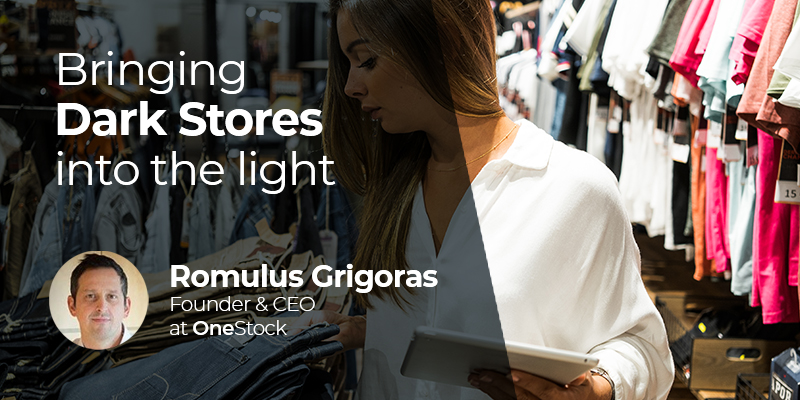Bringing dark stores into the light
As stores reopen, what's the future for dark stores and how will their role change, asks Romulus Grigoras, Founder and CEO of OneStock?
Online grocery company Ocado’s recent results have added more fuel to the fire that UK consumers have changed their shopping habits forever as a result of over a year of full and partial lockdowns. The company, and effectively the original dark store fulfilling from an automated warehouse, announced a 40% rise in sales in the last three months and said it was benefitting from a dramatic and permanent shift towards online shopping.
Looking globally, e-commerce grew by 27.6% in 2020. This dramatic shift has led some retailers to pivot to online while at the same time reviewing the size of their store estate. It is part of this ongoing review that necessitates a hard look at two important business dynamics: profitability and customer behaviour.
The lights are off, but someone’s home - why the store can go dark
Rethinking the role of the store is the right approach both in the short and longer term. Short term, in particular during lockdowns, stock that has been piling up inside closed stores needs to be released and what better way than to use the store as a ‘dark store’ or mini warehouse? The imperative to act in this way is strengthened by the fact that even large warehouses are not yet geared up for the huge growth in online orders and often have neither the staff nor the stock, let alone the systems to manage.
The store sales area is simply transformed into a picking area, the checkouts into a packing area and the dock into a shipping area. Interestingly, our experience has been that the store is quite easy to optimise to maximise the number of orders prepared with a minimum number of employees, and it is certainly welcomed by staff.
Stores operating as order preparation centres during lockdown can clear their inventory and surplus stock by preparing and dispatching web orders, or offering click & collect and reserve & collect orders. When stores reopen to the public, they can start with new stock and avoid what many retailers are having to consider: a massive discounting bonanza. While this may move some stock, almost all profit margins will have been sacrificed and brand equity will be damaged, possibly permanently.
Good for jobs, good for profits
Some brands, such as Jigsaw and PicWicToys, are ahead of the curve. By implementing ship from store and transforming its stores into dark stores, PicWicToys has achieved the same sales performance as when the stores were open. An important additional benefit has been that these retailers have been able to preserve jobs during the crisis.
Longer term, this is about profitability and customer service. By having complete visibility of stock, order and customer, it becomes possible to fulfil each order in the most effective way, which may be about proximity to the customer of the fulfilling store, or a particular store having plenty of stock in demand.
Customer service is optimised because orders can be delivered quickly, but also sustainably as transport costs are reduced. And customers now have more choice – to order online, visit and pay in store, visit and order online and so on. Suddenly, in their eyes, the store acquires new relevance.
Another longer-term consideration, as stores reopen fully, is how to balance the role and function of the store for both on and off-line business. If footfall is down, it makes sense to reduce normal sales area to create a mini-warehouse in the stock room. This area then becomes a dark store, allowing drive-thru or click & collect orders to be prepared as well as 1-hour or standard deliveries.
The sales area is then reduced but remains open and allows the same assortment to be offered to the customer, in the form of a showroom. The customer can test the articles, try them on, make their choice and order them in-store. They will then be able to retrieve the items and pay for those they wish to keep.
Dark stores as a permanent business model
Ultimately, the dark store concept is not a short-term fix during a crisis, but business as usual. The modern consumer browses and shops seamlessly across channels and will always do what is most rewarding and convenient to them at each stage of the journey. Where they were once directed by the retailer because of a lack of systems and processes, now more and more retailers can offer flexibility. And flexibility will be a key attribute for success in the future because, while many people are making predictions about the future role of the store, all we can really know is the store will have to act with agility as consumer tastes and behaviours continue to change.
For instance, many shopping centres were struggling even before the Covid-19 crisis. Amazon quickly capitalised on this decline by developing its own business model and transforming deserted malls into dark stores. While this move has been largely tactical, it is worth considering that, as retailers start to renegotiate their rents with landlords to reflect lower footfalls, the dark store model enables them to compensate with online orders.
As seen in The Retail Times: Read now

Founder & CEO at OneStock
Lorem ipsum dolor sit amet, consectetur adipisicing elit, sed do eiusmod tempor incididunt ut labore et dolore magna aliqua. Ut enim ad minim veniam, quis nostrud exercitation ullamco laboris nisi ut aliquip ex ea commodo consequat.



